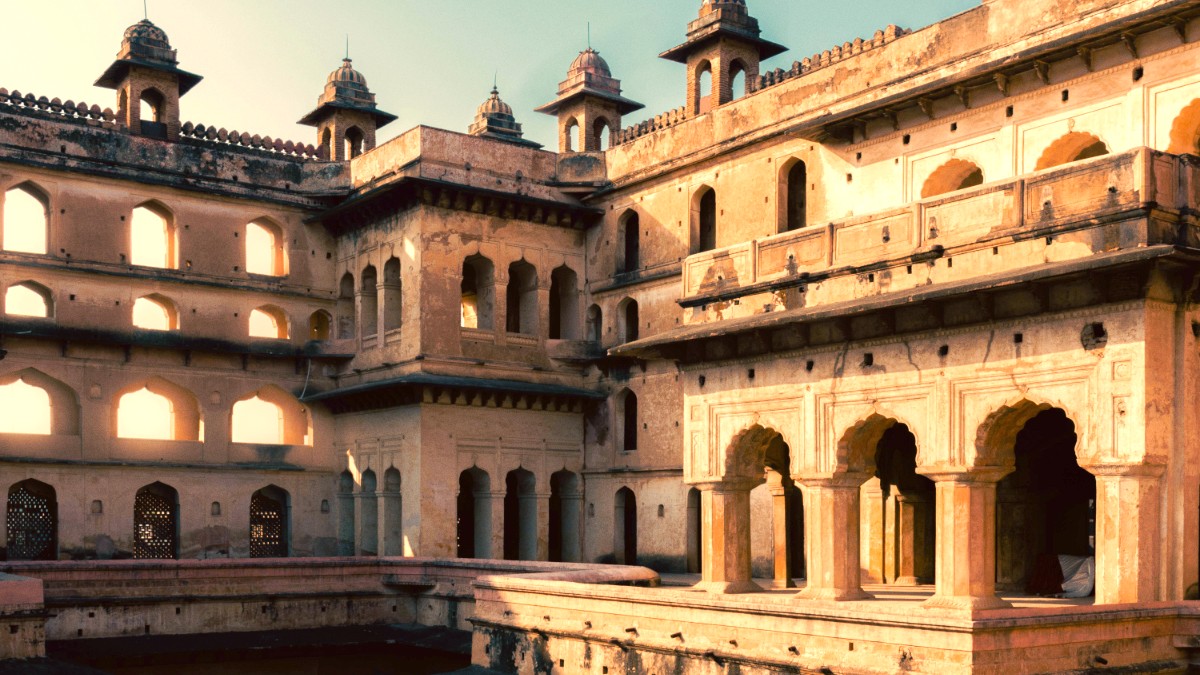
Madhya Pradesh And Chhattisgarh, India
It promises a journey filled with historical wonders and moments of calm reflection.
Orchha sits in the Niwari district of Madhya Pradesh, on the banks of the Betwa River. This location places it within the Bundelkhand region, an area known for its history, spanning parts of Madhya Pradesh and Uttar Pradesh. Orchha lies about 15 kilometers (9.3 miles) from Tikamgarh and approximately 80 kilometers (50 miles) from Jhansi, a well-connected city in Uttar Pradesh.
The Betwa River forms a natural boundary and a source of life for the town, influencing its landscape and traditional activities. Its relatively isolated position, away from major industrial centers, helped preserve its historical structures, allowing them to remain largely intact for centuries. The surrounding terrain is generally flat, with agricultural lands and sparse forests, typical of the Bundelkhand plateau. The river provides a beautiful backdrop for the town's monuments and supports local ecology.
Orchha's history dates back to the 16th century. Rudra Pratap Singh, a Bundela Rajput chief, founded the town around 1501 AD, establishing it as the capital of his kingdom. Under subsequent rulers, specifically Bir Singh Deo in the 17th century, Orchha flourished, becoming a center of art and architecture. The town's structures show a blend of Mughal and Rajput architectural styles, reflecting the cultural interactions of the era. The Jahangir Mahal, a grand palace within the fort complex, exemplifies this fusion, built to honor the Mughal Emperor Jahangir's visit. Its construction showcases intricate stonework, balanced domes, and spacious courtyards.
The decline of the Bundela kingdom in the 18th century led to Orchha losing its status as a capital. This shift prevented further development and modernization, inadvertently preserving its medieval structures in a remarkable state. Today, these well-maintained buildings are a testament to the kingdom's past glory and its enduring architectural heritage. Exploring Orchha means walking through living history, where every monument shares a story of power, art, and faith.
Legend states the idol of Lord Rama, brought from Ayodhya, was placed temporarily in a palace.
Once there, the idol could not be moved, converting the palace into a temple.
Lord Rama is worshipped here not just as a deity, but as the reigning king of Orchha, a distinction unique in India.
This reverence shapes the town's distinct spiritual atmosphere, with daily rituals and strong devotional presence.
The chhatris, royal cenotaphs along the Betwa River, memorialize Orchha's rulers, displaying impressive architecture and offering peaceful reflection.
Orchha is a destination mainly drawing those interested in history and local culture. Its preserved medieval architecture forms the core of its appeal.
Orchha Fort Complex (Jahangir Mahal, Raj Mahal, Rai Praveen Mahal), Ram Raja Temple, Chaturbhuj Temple, and the Chhatris (Royal Cenotaphs) along the Betwa River.
Heritage walks, temple visits (especially evening aarti at Ram Raja Temple), photography, seasonal river activities (rafting/boating), and cultural immersion.
Official visitor statistics for Orchha are limited. A steady stream of domestic and international tourists arrive annually, with numbers rising during the cooler months. Tourism and agriculture form the main industries, supporting the local population of approximately 10,000 residents within the town area. Orchha remains a peaceful place, less crowded than major Indian cities, presenting an intimate travel experience.
Orchha's unique historical and spiritual ambiance makes it a distinct destination in India. Its relatively small size and slower pace distinguish it from the country's bustling metropolises, allowing for a more focused and contemplative exploration of its rich heritage.
The blend of grand architecture, devotional practices, and natural beauty around the Betwa River crafts a memorable journey for visitors.
Explore palaces and temples showing an unique blend of Mughal and Rajput styles.
Experience a town where Lord Rama is revered as the living king.
Capture stunning reflections of chhatris along the scenic Betwa River.
Orchha is best explored during the cooler winter months (October to February) for comfortable sightseeing. While local medical facilities are limited, Jhansi (30 minutes away) has larger hospitals. Always drink bottled water and maintain good hygiene.